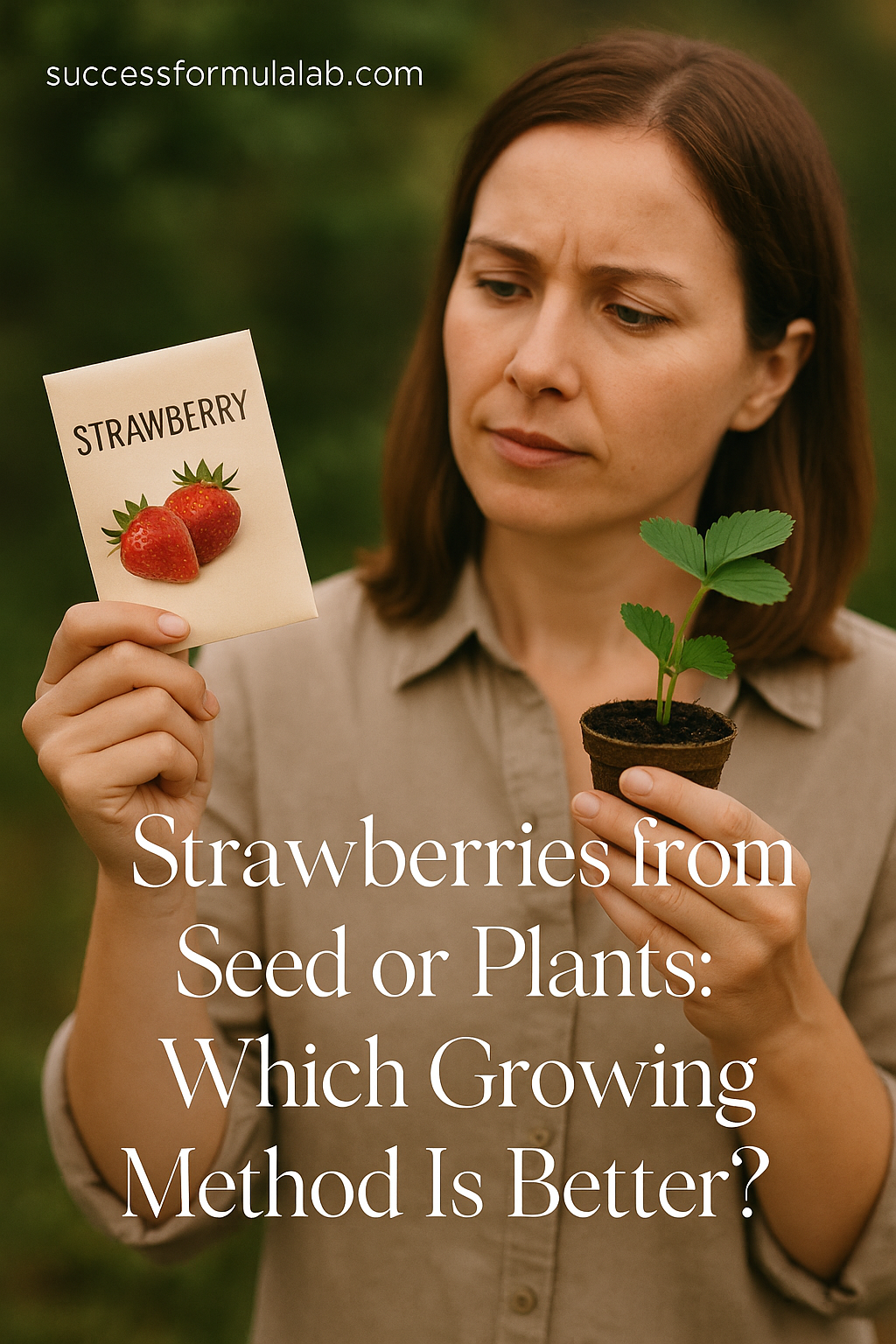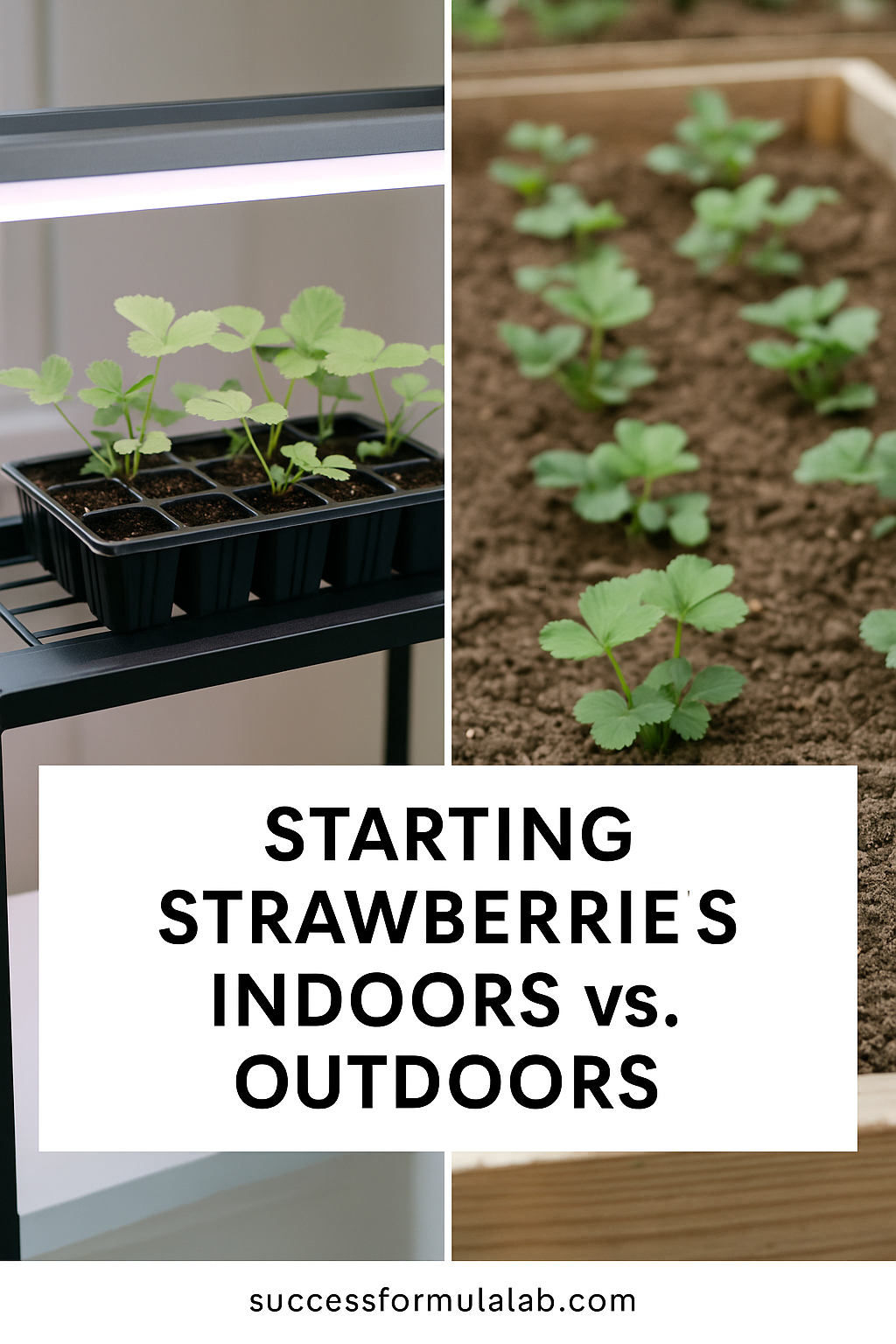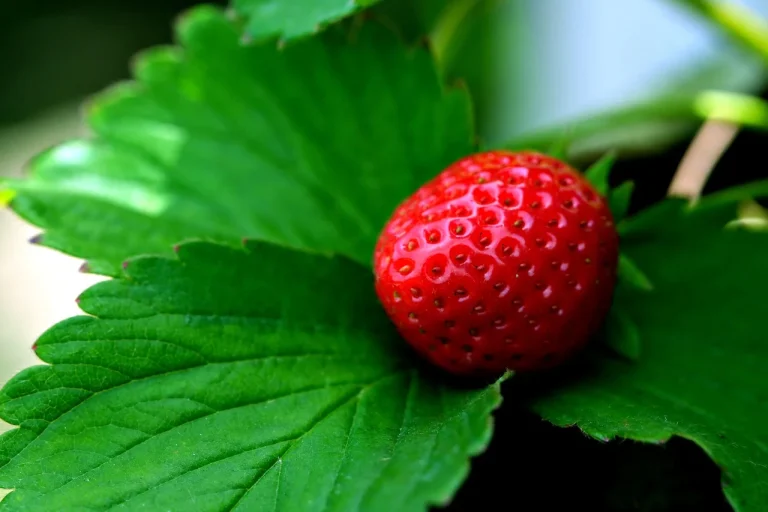When you’re ready to grow your own strawberries, there’s one question you’ll face early on: Should you start strawberries from seed or buy starter plants? Both options can lead to a fruitful harvest, but they come with very different levels of cost, effort, speed, and satisfaction.

Choosing the right method depends on your goals, timeline, gardening experience, and how involved you want to be in the process. This article breaks down the pros and cons of each approach to help you make a confident, informed decision that suits your garden and your lifestyle.
Comparing the Two Methods
You have two main options when growing strawberries at home: starting from seed or buying plants. Here’s a closer look at each.
Growing Strawberries from Seed
If you’re someone who enjoys a hands-on experience and doesn’t mind waiting for results, growing from seed gives you complete control from day one. You’ll need to cold-stratify the seeds (simulate winter dormancy), start them indoors under the right light conditions, and nurture them through germination.
What you gain in effort, though, is a stronger, more adaptable plant. It may take longer to see fruit, but the journey is incredibly rewarding.
Buying Starter Plants
If you’re short on time or new to gardening, starter plants offer a quick and easy route to a strawberry harvest. These can be bare-root or potted plants, and they’re ready to plant straight into your garden or container setup.
The trade-off is that you’re typically limited to fewer variety options, and the cost per plant can add up if you want to grow a large batch.
Cost Comparison: Seeds vs. Plants
Let’s break down the budget differences:
Growing from Seed
- Seeds: $2–$5 per packet (can yield 20–100 plants)
- Supplies needed: Seed trays, soil mix, grow lights
- Cost per plant: $0.10–$0.25 (after setup)
Buying Plants
- Bare-root plants: $1–$3 each
- Potted plants: $4–$7 each
- Minimal setup required
| Expense | From Seed | From Plants |
|---|---|---|
| Initial Investment | Low (more tools needed) | Moderate to high |
| Per-Plant Cost | Very low | Higher |
| Long-Term Savings | Excellent | Moderate |
If you plan to grow many strawberries or garden for multiple seasons, the seed route can pay off significantly over time.
Time Investment and Patience
Time is often a deciding factor.

From Seed
- Cold stratification: 2–4 weeks
- Germination: 1–6 weeks
- Time to fruit: 5–6 months total
From Plants
- Planting: Immediate
- Time to fruit: 1–2 months after transplanting
| Phase | From Seed | From Plants |
|---|---|---|
| Preparation | Longer (more steps) | Simple setup |
| First Harvest | Delayed | Relatively fast |
| Ideal Start Time | Late winter (indoors) | Spring (outdoors) |
If you’re gardening in a short-season climate or want strawberries this year, buying plants may be the better option.
Variety and Customization
Seeds give you the power to grow varieties not found in stores. Want small alpine berries, heirloom types, or gourmet options? They’re usually only available in seed form.
In contrast, store-bought plants are often limited to hybrid varieties like June-bearing or everbearing strawberries, which are great—but not very adventurous.
Skill Level and Effort
This is where the two methods really diverge.

Seeds
- Require knowledge of stratification and seed-starting
- Need proper light, moisture, and temperature control
- Best for intermediate or committed beginner gardeners
Starter Plants
- Plug and play—you just dig a hole and water
- Ideal for complete beginners
- Great for kids and those looking for a quick win
If you’re just testing the waters or gardening for the first time, plants offer a much easier entry point. But if you’re after the full gardening experience, seeds give you more learning opportunities and personal satisfaction.
Long-Term Growth and Plant Health
Plants grown from seed often develop deeper, more resilient root systems. They adapt better to your local soil and conditions because they’ve grown up in it. Over time, this means stronger plants and potentially more fruit.
Plants purchased from nurseries, while convenient, sometimes experience transplant shock or may not be acclimated to your specific growing zone. They can still thrive, but they might need a little more attention early on.
Choosing What’s Best for You
Let’s simplify the decision-making process:
Choose Seeds If:
- You love starting from scratch
- You want rare or heirloom varieties
- You don’t mind waiting for results
- You’re willing to invest time and effort upfront
Choose Plants If:
- You want fruit quickly
- You’re new to gardening
- You prefer a more hands-off approach
- You have limited space or tools
No matter your choice, both methods can be successful and rewarding. Your preference and gardening style will guide you to the right fit.
If your ultimate goal is to grow more than just strawberries—perhaps to become less reliant on grocery stores and more self-sufficient—you may want to consider taking things a step further.
This comprehensive guide to building a self-sufficient backyard is packed with strategies to grow food, harvest water, compost efficiently, and create a resilient, productive garden that works with nature—not against it.
Building a Productive Garden That Does More
Whether you go the seed route or buy plants, it’s the beginning of something bigger. If you’re ready to take full control of your food supply and maximize what your land can do, The Self-Sufficient Backyard is your next step.
You’ll learn how to:
- Grow year-round with minimal space
- Set up water-saving systems
- Create compost that feeds your garden
- Reduce costs and increase self-reliance
Explore the guide here and turn your home garden into a full-scale food solution.
FAQ – Starting Strawberries from Seed vs. Buying Plants
Is it harder to grow strawberries from seed?
Yes, but only slightly. It requires more steps and patience but results in hardy plants.
Will plants grown from seed produce less fruit?
No. With proper care, they can yield just as much as store-bought plants.
Can I grow strawberries from seed indoors?
Absolutely. You can start seeds indoors during late winter for a spring transplant.
Is there a bigger variety in seed form?
Yes. Seeds give you access to alpine, heirloom, and organic varieties you won’t find as plants.
What’s the quickest way to get strawberries?
Buying starter plants is the fastest option. They typically fruit within 1–2 months.
Final Thoughts
The choice between starting strawberries from seed and buying plants comes down to your goals. If you’re looking for an educational, involved gardening experience with long-term benefits, seeds are the way to go. If you want speed and simplicity, starter plants are your best bet.
Whatever you decide, the result is the same: juicy, homegrown strawberries that taste like summer. And once you master that, you’ll be ready to explore everything else your backyard can offer.

